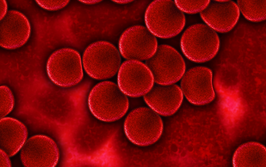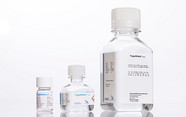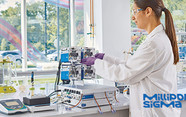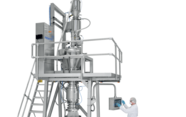2025 Predictions for RNA Therapeutics
So much has already been achieved with RNA – and it’s only going to get better.
Kate Broderick | | 5 min read

As 2025 begins, I believe that we are deep in the era of RNA therapeutic innovation. The industry’s collective response to the COVID-19 pandemic has accelerated the widespread adoption of mRNA-based medicines, showcasing their powerful potential and bringing other RNA therapeutic modalities into the global spotlight. The number of conditions considered for treatment with RNA-based therapies, ranging from cancer to gene therapy for rare genetic disorders, has grown exponentially, but the field has yet to reach its full potential. In the coming years, advancements in targeting specificity and RNA manufacturing processes will further solidify the significance of these innovative therapies. Improving manufacturing flexibility at both large and small scales, enabling more precise delivery, and maximizing efficacy while minimizing immunogenicity are all key benchmarks that will help advance more candidate RNA therapeutics through development and commercialization. The year ahead will be filled with challenges and opportunities in developing RNA-based therapeutics, including a scale-up approach, market differentiation, managing manufacturing costs, and more.
RNA-based vaccines are less complex to produce at scale compared to more traditional vaccine counterparts. This efficiency is partly because of the cell-free production of RNA, which can be easily scaled for mass manufacturing. Additionally, the sequence of an RNA-based vaccine can be altered readily to adapt to any changes, such as when a virus mutates.
To make large-scale production of mRNA vaccines a reality, manufacturers invested millions of dollars in infrastructure to produce the raw material input for mRNA, as well as in platforms and processes. However, as the field evolves to encompass broader therapeutic targets, RNA manufacturers are adapting their processes to provide a spectrum of production offerings to encompass the diverse needs of developers.
Therapeutic developers are now focusing on a more comprehensive array of applications beyond infectious disease vaccines. These include the production of RNA therapeutics for personalized treatments of cancers or for rare diseases with small patient populations closer to the scale of thousands rather than tens of millions. The manufacturing approach for these products is radically different from the processes for vaccine production for a global pandemic. Now, RNA manufacturers may need hundreds of small-scale bioreactors instead of a single, large bioreactor. I foresee this transition and the setup of agile small-scale GMP-grade RNA production, while still maintaining large-scale capabilities, as a step-change for the field in the coming year. However, while the production scale is dramatically different in small-batch production, the process development knowledge RNA manufacturers have developed thus far is still applicable to meeting these needs.
As the spectrum of RNA-based therapeutic indications broadens, RNA manufacturers will have to adapt to meet the use case. Large-scale production will still be necessary for pharma and biotech developers working on major infectious disease targets, such as influenza. NGOs and government entities may also require support for stockpiling raw materials and vaccines in the event of another global health crisis. On the other end of the production spectrum are developers that need small-scale, rapidly produced batches of RNA for more niche and cancer therapies and rare disease treatments. This can include biotech companies, as well as academic clinical centers. RNA manufacturers must maintain agile capacity for both groups so we can embrace the broad spectrum of applications of RNA-based therapeutics and treat as many patients as possible.
A related challenge in the RNA therapeutic space is cost. While manufacturers don't ultimately dictate how the cost of producing a therapy is passed onto patients, we can take steps to optimize processes to reduce production costs.
In the case of small-batch RNA production, there are two primary approaches: increasing potency or streamlining the process. Increasing the potency of products allows manufacturers to produce the same amount of RNA but obtain more doses per unit of volume, reducing costs. The second approach is to streamline the process of producing the RNA in the first place, and this can be achieved with chemically modified RNAs optimized for higher yields and more efficient production. I anticipate that both approaches will empower RNA manufacturers in 2025 to create small-scale batches in a more cost-efficient way.
New RNA horizons
We also shouldn’t forget about CRISPR when it comes to RNA. GMP-grade RNAs have been pivotal not only in the production of COVID-19 vaccines, but also for use in CRISPR gene editing applications. In 2025, I expect to see more use of RNA-encoded nucleases in CRISPR applications and an acceleration of research in the RNA editing field. In fact, multiple clinical trials are underway that examine the use of RNA editing for a variety of therapeutic indications. RNA editing approaches can target transiently expressed RNA rather than permanent modifications in DNA nuclease-based gene editing, which has several potential benefits for safety and efficacy. The permanent nature of DNA editing means that off-target edits can result in long-term harm, while any off-target effects of RNA editing are limited to the lifespan of the RNA. Additionally, rather than having permanent effects on the genome, RNA editing can enable fine-tuned, temporary regulation of gene expression to enable more dynamic and targeted therapeutic applications.
I also anticipate the field examining diverse modified RNA bases to alter the profile of a given product. The 2023 Nobel Prize in Medicine was awarded for the discovery of nucleoside base modifications that reduced immunogenicity and increased protein production of mRNA therapeutics, directly empowering the development of the mRNA-based COVID-19 vaccines. I believe this is only the beginning. Further innovation of modified RNA, as well as novel applications, will likely power continued progress in RNA therapeutic development.
As RNA therapeutic development and innovation continue into 2025, it’s clear this technology has the potential to revolutionize healthcare. As RNA manufacturers, we are responsible for ensuring that it reaches its full potential. The lessons learned from the COVID-19 pandemic have accelerated the development and adoption of RNA-based therapies. While the industry’s initial focus was on large-scale vaccine production, the future of RNA therapeutics lies in addressing a diverse range of diseases, including rare disorders and personalized medicine.
As this field continues to evolve, it is essential to prioritize quality, efficiency, and patient safety. Collaboration among researchers, manufacturers, and regulatory agencies will be vital in unlocking the full potential of RNA therapeutics and improving the lives of patients worldwide.
Chief Innovation Officer of Maravai Life Sciences and TriLink Biotechnologies



















